Towards High-Resolution Population Mapping: Leveraging Open Data, Remote Sensing, and AI for Geospatial Analysis in Developing Country Cities—A Case Study of Bangkok
Abstract
1. Introduction
1.1. Background
1.2. Challenges Posed by Urban Population Growth
1.3. Existing Studies and Challenges in Population Mapping
1.4. Research Objectives
- Developing a globally applicable micro-dasymetric population mapping framework to enable high-resolution, building-level population estimation by incorporating methods for imputing missing attributes.
- Leveraging open geospatial data and remote sensing technologies to enhance the accuracy and scalability of population mapping while integrating advanced data processing techniques to refine missing or incomplete building attributes.
- Testing and validating the model using openly available datasets and integrating advanced population mapping techniques with geospatial tools and machine learning-based imputation methods to enhance estimation accuracy.
- Establishing a cost-effective and continuously updatable population estimation model to overcome the limitations of traditional census-based approaches, ensuring scalability and long-term applicability in data-scarce environments, particularly in developing countries.
2. Material
2.1. Study Area
2.2. Data Sources
| Characteristic | AW3D30 | NASADEM |
|---|---|---|
| Spatial resolution (m) | 30 | 30 |
| Vertical accuracy (m) | <5 | 3.5 |
| Datum | ITRF97 and GRS80, using EGM96 | WGS84/EGM96 |
| Methodology | Photogrammetry | Interferometric SAR |
| Data source | ALOS PRISM | SRTM, ASTER GDEM, ICESat |
2.3. Validation and Training Data
3. Methods
3.1. Population Distribution
- vij: volume of the building j in subarea i.
- sij: area of the building j in subarea i.
- fij: number of floors of building j in subarea i.
- hij: number of households assigned to building j in subarea i.
- Hi: total number of households in subarea i.
- m: number of buildings in the subarea.
- rij: number of residents assigned to building j in subarea i.
- Ri: total number of residents in subarea i.
3.2. Building Attributes
3.2.1. Building Height Estimation
- fSHM: surface height model.
- fAW3D30: surface elevation from AW3D30, non-ground points.
- fDTM: terrain elevation derives from AW3D30, ground points.
- εB(∙): morphological erosion operation with structuring element B.
- B: structuring element (SE).
- cSHMij: corrected SHM at position (i,j).
- SHMij: SHM at position (i,j).
- slopeij: slope value at position (i,j).
- : slope correction based on terrain.
- x: threshold slope percentage.
- SHM(x,y): elevation value at a given pixel location (x,y).
- BFi: building footprint i.
- N: total number of pixels within the building footprint.
3.2.2. Building Use Classification
- Polygon-Based Classification Model.
- Image-Based Classification Model.
4. Results
4.1. Building Height Estimation Results
4.2. Building Use Classification Results
4.3. Population Estimation Results
- One household per unit in detached houses.
- A total of 16.16 m2 per household in mixed-use buildings.
- A total of 78.66 m2 per household in townhouses.
5. Discussion
5.1. Morphological Approach for Estimating Building Height Estimation
5.2. Machine Learning for Building Use Classification
5.3. Analysis of Population Distribution
6. Conclusions
Author Contributions
Funding
Data Availability Statement
Acknowledgments
Conflicts of Interest
Abbreviations
| DEM | Digital Elevation Model |
| DSM | Digital Surface Model |
| DTM | Digital Terrain Model |
| POI | Points of Interest |
| OSM | OpenStreetMap |
| SHM | Surface Height Model |
Appendix A
Appendix A.1. Validation Data Collection
| Attribute | Description |
|---|---|
| Building Use Classification | Commercial, condominium, detached commercial, detached residential, mixed-use (primarily commercial), mixed-use (primarily residential), other, townhouse |
| Building Condition | Clean, intermediate, or deteriorated |
| Building Height | The height of the building, expressed as the number of floors |
| Number of Posts | The count of visible utility or structural posts associated with the building or property |
| Vacant House Indicator | Identifying whether the property is vacant or unoccupied |
| X, Y Coordinates | The longitude–latitude value of the building’s geographic location |
| Area | Land Use Characteristics | Characteristics |
|---|---|---|
| 1. Phaya Thai District | Central Business and Commercial Area | The district is notable for its condominium and commercial development, attracting young workforces. The west side boasts businesses, mid-to-high-end townhouses, shops, and detached buildings. In contrast, the east side features terraced houses and detached buildings. |
| 2. Bang Khen District | Residential Area | Transitional urban–suburban residential area located near the military base and airport. It features smaller enterprises in the townhouses and detached residential units. |
| 3. Bang Kapi District | Residential Area | Located on the eastern side of Bangkok. It boasts a prominent shopping center that serves as a transportation hub, connecting the canal and rail networks. The area also features townhouses along the primary road and large detached residences. |
| 4. Vadhana District | Central Business and Commercial Area | Prominent central business and commercial area. Mix of office buildings, condominiums, and mid- and high-end residential buildings. Features vibrant retail, dining, and entertainment hubs, making it a hotspot for both residents and visitors. |
| 5. Saphan Sung District | Residential Area | Quiet residential area on the east side of the Bangkok city center, comprising well-planned detached houses, townhouses, and gated communities. |
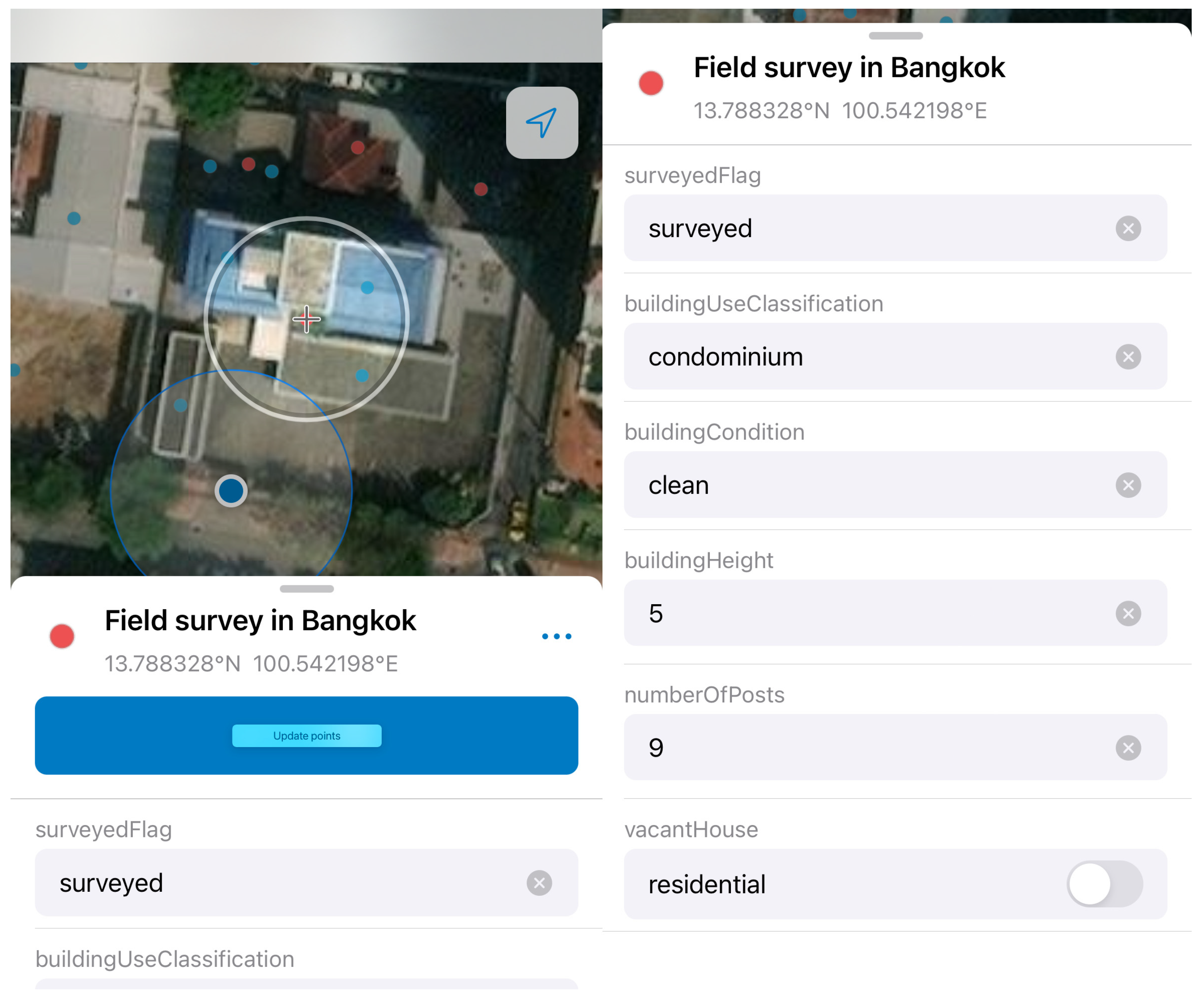

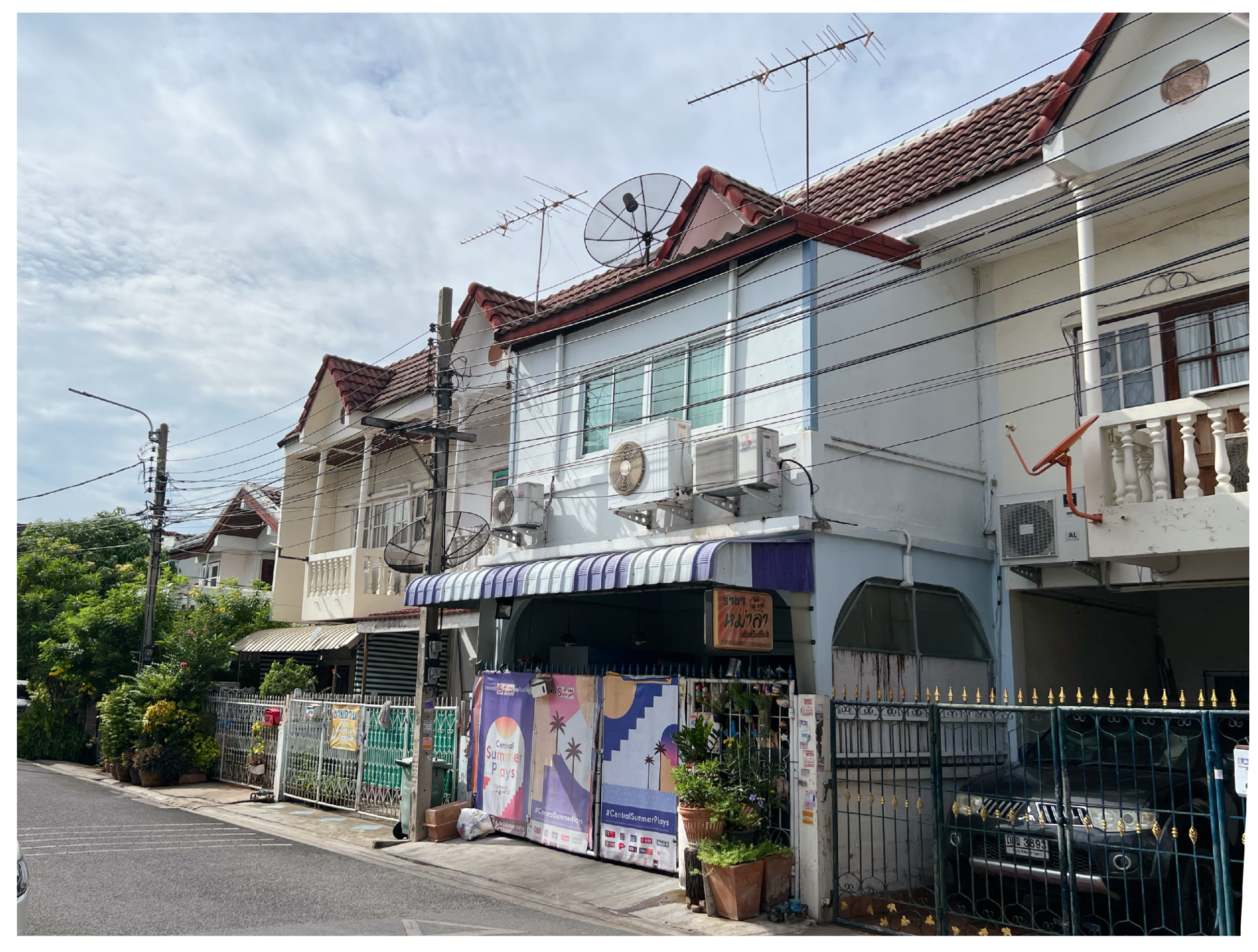
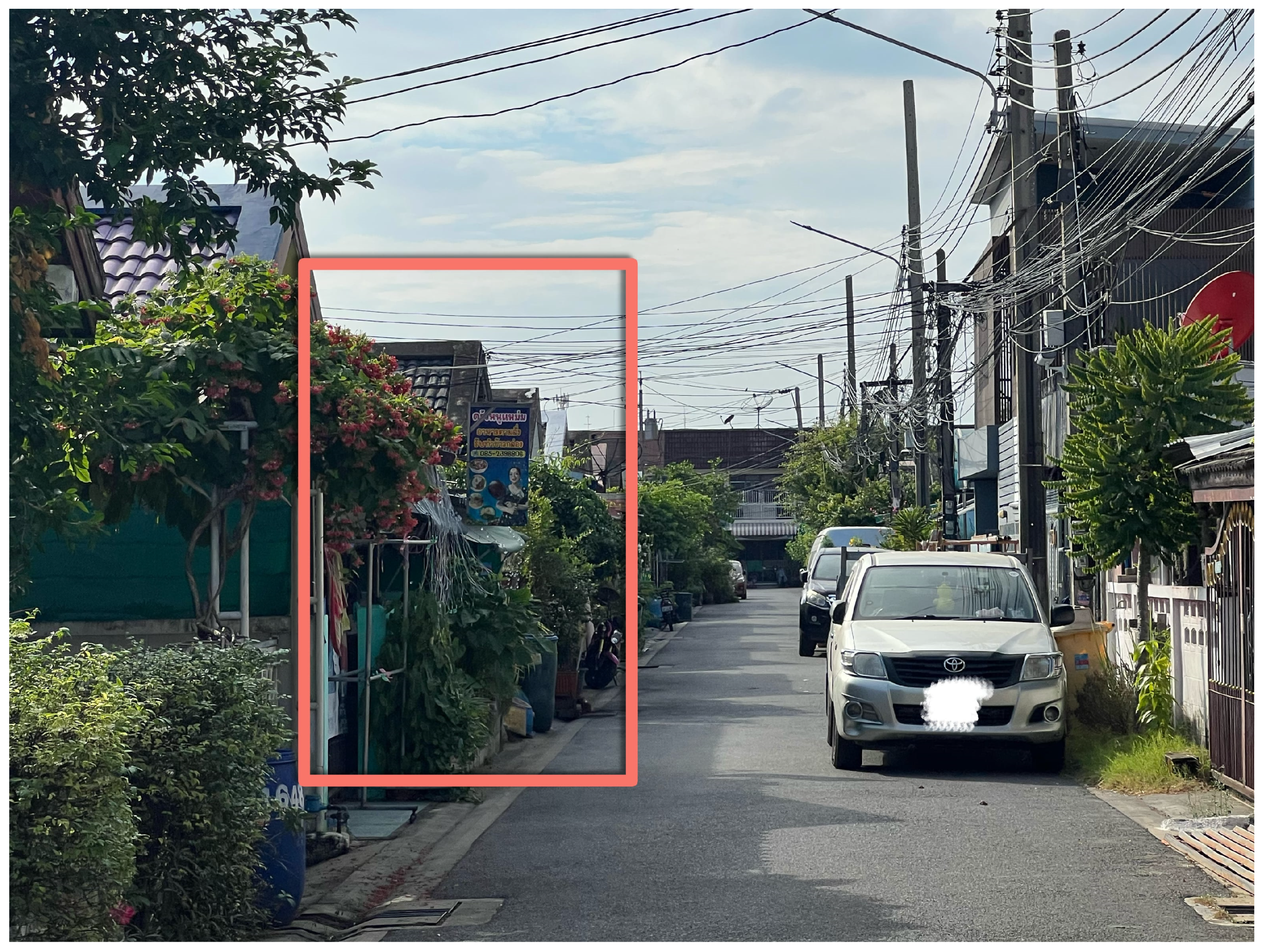

Appendix A.2. Validation Data Sample and Statistics
| ID | Surveyed Flag | Building Use Classification | Building Height | Number of Posts | x | y |
|---|---|---|---|---|---|---|
| 1 | Surveyed | Detached residential | 2 | 1 | 100.630983 | 13.7789598 |
| 2 | Surveyed | Condominium | 3 | 4 | 100.617464 | 13.8918068 |
| 3 | Surveyed | Mixed-use (primarily residential) | 3 | 2 | 100.605937 | 13.8933387 |
| 4 | Surveyed | Detached residential | 2 | 1 | 100.627159 | 13.7745783 |
| 5 | Surveyed | Detached residential | 1 | 1 | 100.626576 | 13.7747678 |
| … | … | … | … | … | … | … |
| District | Count | |
|---|---|---|
| 1 | Phaya Thai | 362 |
| 2 | Bang Khen | 424 |
| 3 | Bang Kapi | 636 |
| 4 | Vadhana | 675 |
| 5 | Saphan Sung | 767 |
| Building Type | Count |
|---|---|
| Detached residential | 1416 |
| Detached commercial | 71 |
| Condominium | 277 |
| Mixed-use (primarily residential) | 186 |
| Mixed-use (primarily commercial) | 199 |
| Commercial | 329 |
| Townhouse | 101 |
| Others | 285 |
| Total | 2864 |
| Building Floor | Count |
|---|---|
| 1–3 | 2344 |
| 4–6 | 419 |
| 7–10 | 55 |
| 11- | 46 |
Appendix B
| Feature Types | Feature Name | Aggregation Methods | Summary |
|---|---|---|---|
| Derived from building polygons | Area | Calculated for each building | Building area |
| Circumference | Calculated for each building | Length of building perimeter | |
| Number of vertices | Calculated for each building | Number of vertices in the building (polygon) | |
| Shape complexity | Calculated for each building | ||
| Number of buildings in the vicinity | Calculated by straight-line distance from the center of gravity of the building | The number of buildings within a radius of 100 m from the center of gravity of the building is calculated and added | |
| Derived from OpenStreetMap | Distance to POI | Straight-line distance from the center of gravity of the building | Straight-line distance from the center of gravity of the building to the POI data of each type (see table) is calculated |
| Distance to the road | Straight-line distance from the center of gravity of the building | Calculated straight-line distance from the center of gravity of a building to a major road | |
| Types of roads | Calculated for each building | The type of road with the shortest distance | |
| Distance to rail | Straight-line distance from the center of gravity of the building | Calculated straight-line distance from the center of gravity of the building to the railway (line data) | |
| Distance to train station | Straight-line distance from the center of gravity of the building | Calculated straight-line distance from the center of gravity of a building to a railway station (including subway) | |
| Derived from DEM | Building height | Calculated for each building | From the previous section |
| Category | Specific POI Types | Summary |
|---|---|---|
| Public facilities | School, library, town hall, hospital, police, fire station, post office, government building | Facilities that provide public services such as education, administration, medical care, and public safety |
| Commercial facilities | Shop, restaurant, cafe, bar, fast food, market, hotel, hostel | Facilities related to daily commercial activities, such as shopping, dining, lodging, etc. |
| Transportation facilities | Bus stop, parking, bicycle parking, airport, terminal | Transportation-related infrastructure facilities used by people as a means of transportation |
| Tourist facilities | Museum, attraction, viewpoint, artwork, gallery, tourist information | Facilities for the purpose of tourism and cultural activities |
| Leisure facilities | Park, playground, sports center, stadium, swimming pool | Facilities that promote outdoor activities and recreation |
| Service facilities | Bank, ATM, pharmacy, clinic, dentist, veterinary clinic | Facilities that provide financial, medical, and other services necessary in daily life |
| Accommodation | Hotel, hostel, guesthouse, apartment, campsite | Facilities that provide accommodation |
| Emergency response facilities | Police station, fire station, hospital, first aid station | Facilities for responding to emergencies |
| Sports facilities | Stadium, sports center, pool, sports pitch, track | Facilities for sporting events and practices |
References
- Ritchie, H.; Samborska, V.; Roser, M. “Urbanization” Published Online at OurWorldinData.org. Available online: https://ourworldindata.org/urbanization (accessed on 31 December 2024).
- Gu, D.; Andreev, K.; Dupre, M.E.; United Nations Population Division, New York, USA. Department of Population Health Sciences & Department of Sociology, Duke University, North Carolina, USA Major Trends in Population Growth Around the World. China CDC Wkly. 2021, 3, 604–613. [Google Scholar] [CrossRef] [PubMed]
- Sun, L.; Chen, J.; Li, Q.; Huang, D. Dramatic Uneven Urbanization of Large Cities throughout the World in Recent Decades. Nat Commun 2020, 11, 5366. [Google Scholar] [CrossRef]
- United Nations. The Speed of Urbanization Around the World; United Nations: New York, NY, USA, 2018. [Google Scholar]
- Alirol, E.; Getaz, L.; Stoll, B.; Chappuis, F.; Loutan, L. Urbanisation and Infectious Diseases in a Globalised World. Lancet Infect. Dis. 2011, 11, 131–141. [Google Scholar] [CrossRef] [PubMed]
- UN. Economic and Social Council (2014–2015: New York and Geneva). 2020 World Population and Housing Census Programme: Resolution/Adopted by the Economic and Social Council; E/2015/24; 2015; 2p. Available online: https://digitallibrary.un.org/record/798584 (accessed on 30 December 2024).
- Mahtta, R.; Fragkias, M.; Güneralp, B.; Mahendra, A.; Reba, M.; Wentz, E.A.; Seto, K.C. Urban Land Expansion: The Role of Population and Economic Growth for 300+ Cities. npj Urban Sustain. 2022, 2, 5. [Google Scholar] [CrossRef]
- Park, J.; Gall, H.E.; Niyogi, D.; Rao, P.S.C. Temporal Trajectories of Wet Deposition across Hydro-Climatic Regimes: Role of Urbanization and Regulations at U.S. and East Asia Sites. Atmos. Environ. 2013, 70, 280–288. [Google Scholar] [CrossRef]
- Liang, L.; Wang, Z.; Li, J. The Effect of Urbanization on Environmental Pollution in Rapidly Developing Urban Agglomerations. J. Clean. Prod. 2019, 237, 117649. [Google Scholar] [CrossRef]
- Sancino, A.; Stafford, M.; Braga, A.; Budd, L. What Can City Leaders Do for Climate Change? Insights from the C40 Cities Climate Leadership Group Network. Reg. Stud. 2022, 56, 1224–1233. [Google Scholar] [CrossRef]
- Japan International Cooperation Agency; Infrastructure and Peacebuilding Department. Thematic Guidelines on Urban and Regional Development; Japan International Cooperation Agency: Tokyo, Japan, 2017. [Google Scholar]
- Dickson-Gomez, J.; Nyabigambo, A.; Rudd, A.; Ssentongo, J.; Kiconco, A.; Mayega, R.W. Water, Sanitation, and Hygiene Challenges in Informal Settlements in Kampala, Uganda: A Qualitative Study. Int. J. Environ. Res. Public Health 2023, 20, 6181. [Google Scholar] [CrossRef]
- Rahaman, M.A.; Kalam, A.; Al-Mamun, M. Unplanned Urbanization and Health Risks of Dhaka City in Bangladesh: Uncovering the Associations between Urban Environment and Public Health. Front. Public Health 2023, 11, 1269362. [Google Scholar] [CrossRef]
- Green, R. Informal Settlements and Natural Hazard Vulnerability in Rapid Growth Cities. In Hazards and the Built Environment; Routledge: London, UK, 2008; pp. 218–237. [Google Scholar]
- Guo, Y.; Zhang, Q.; Lai, K.K.; Zhang, Y.; Wang, S.; Zhang, W. The Impact of Urban Transportation Infrastructure on Air Quality. Sustainability 2020, 12, 5626. [Google Scholar] [CrossRef]
- Guo, Y.; Lu, Q.; Wang, S.; Wang, Q. Analysis of Air Quality Spatial Spillover Effect Caused by Transportation Infrastructure. Transp. Res. Part D Transp. Environ. 2022, 108, 103325. [Google Scholar] [CrossRef]
- Andreasen, M.H.; Agergaard, J.; Allotey, A.N.M.; Møller-Jensen, L.; Oteng-Ababio, M. Built-in Flood Risk: The Intertwinement of Flood Risk and Unregulated Urban Expansion in African Cities. Urban Forum 2023, 34, 385–411. [Google Scholar] [CrossRef]
- Bastos Moroz, C.; Thieken, A.H. Urban Growth and Spatial Segregation Increase Disaster Risk: Lessons Learned from the 2023 Disaster on the North Coast of São Paulo, Brazil. Nat. Hazards Earth Syst. Sci. 2024, 24, 3299–3314. [Google Scholar] [CrossRef]
- Yin, X.; Li, P.; Feng, Z.; Yang, Y.; You, Z.; Xiao, C. Which Gridded Population Data Product Is Better? Evidences from Mainland Southeast Asia (MSEA). Int. J. Geo-Inf. 2021, 10, 681. [Google Scholar] [CrossRef]
- Cartagena-Colón, M.; Mattei, H.; Wang, C. Dasymetric Mapping of Population Using Land Cover Data in JBNERR, Puerto Rico during 1990–2010. Land 2022, 11, 2301. [Google Scholar] [CrossRef]
- Pirowski, T.; Szypuła, B. Dasymetric Population Mapping Using Building Data. Ann. Am. Assoc. Geogr. 2024, 114, 1001–1019. [Google Scholar] [CrossRef]
- Pelletier, F. Census Counts, Undercounts and Population Estimates: The Importance of Data Quality Evaluation. Tech. Pap. 2020, 2, 10. [Google Scholar]
- Maneepong, K. High-Resolution Population Mapping: Challenges Where the Actual Residences Differ from the Records; Tokyo City University: Tokyo, Japan, 2022. [Google Scholar]
- National Statistical Office Thailand Population from the Census Categorized by Age Group, Gender. Available online: https://catalog.nso.go.th/dataset/4f98f5a8-f904-49f9-8665-b5975e0a6f3d (accessed on 14 January 2025).
- Office of the Official Information Commission. Meeting Report of the Academic Advisory Committee 1/2021; Office of the Official Information Commission—National Statistical Office: Bangkok, Thailand, 2021. [Google Scholar]
- Hrishikesh, S. Census in India: Baffling Lack of Data Is Hurting Indians. Available online: https://www.bbc.com/news/world-asia-india-64282374 (accessed on 5 March 2025).
- Nair, A. A Nation in the Dark: Census Delay Risks India’s Future. Available online: https://www.policycircle.org/policy/india-census-2021-and-policy/ (accessed on 6 March 2025).
- United Nations. Population Fund Technical Brief on the Implications of COVID-19 on Census. Available online: https://www.unfpa.org/resources/technical-brief-implications-covid-19-census (accessed on 8 March 2025).
- WorldPop. Gridded Population Estimate Datasets and Tools. Available online: https://www.worldpop.org/methods/populations/ (accessed on 10 September 2024).
- European Commission. Joint Research Centre. In GHSL Data Package 2019: Public Release GHS P2019; Publications Office: Luxembourg, 2019. [Google Scholar]
- Skinner, C. Issues and Challenges in Census Taking. Annu. Rev. Stat. Appl. 2018, 5, 49–63. [Google Scholar] [CrossRef]
- Emeh, I.E.; Olise, C.N.; Idam, M.O.; Nwokolo, C.C. Regular Population Census and Sustainable National Development in Nigeria; A Cost And Benefit Analysis. J. Public Adm. Gov. 2020, 10, 53. [Google Scholar] [CrossRef]
- Jain, G.; Espey, J. Lessons from Nine Urban Areas Using Data to Drive Local Sustainable Development. npj Urban Sustain. 2022, 2, 7. [Google Scholar] [CrossRef]
- Ruggles, S.; Magnuson, D.L. “It’s None of Their Damn Business”: Privacy and Disclosure Control in the U.S. Census, 1790–2020. Popul. Dev. Rev. 2023, 49, 651–679. [Google Scholar] [CrossRef] [PubMed]
- Gonçalves, H.; Tomasi, E.; Tovo-Rodrigues, L.; Bielemann, R.M.; Machado, A.K.F.; Ruivo, A.C.C.; Bortolotto, C.C.; Jaeger, G.P.; Xavier, M.O.; Fernandes, M.P.; et al. Population-Based Study in a Rural Area: Methodology and Challenges. Rev. De Saúde Pública 2018, 52, 3s. [Google Scholar]
- Nnanatu, C.C.; Chaudhuri, S.; Adewole, W.A.; Yankey, O.; Tejedor, N.; Tatem, A.J. Small Area Population Estimates in High-Rise Buildings: A Case Study in Thailand. Available online: https://data.worldpop.org/repo/prj/Resources/Posters/THAI_Modelling_poster.pdf (accessed on 12 November 2024).
- Lansley, G.; Li, W.; Longley, P.A. Creating a Linked Consumer Register for Granular Demographic Analysis. J. R. Stat. Soc. Ser. A: Stat. Soc. 2019, 182, 1587–1605. [Google Scholar] [CrossRef]
- Li, C.; Managi, S. Gridded Datasets for Japan: Total, Male, and Female Populations from 2001–2020. Sci. Data 2023, 10, 81. [Google Scholar] [CrossRef] [PubMed]
- Eurostat Population and Housing Census 2021—Population Grids. Available online: https://ec.europa.eu/eurostat/statistics-explained/index.php?title=Population_and_housing_census_2021_-_population_grids (accessed on 9 January 2025).
- Synergos Technologies STI: PopStatsTM: Quarterly Demographic Data. Available online: https://www.synergos-tech.com/popstats/ (accessed on 21 February 2025).
- Globetech Co., Ltd. Demographic Contents. Available online: https://www.nostramap.com/demographiccontents/ (accessed on 21 February 2025).
- Environics Analytics DemoStats|Demographic Data. Available online: https://environicsanalytics.com/en-ca/data/demographic/demostats (accessed on 21 February 2025).
- Metzger, N.; Daudt, R.C.; Tuia, D.; Schindler, K. High-Resolution Population Maps Derived from Sentinel-1 and Sentinel-2. arXiv 2024, arXiv:2311.14006. [Google Scholar] [CrossRef]
- Boo, G.; Darin, E.; Leasure, D.R.; Dooley, C.A.; Chamberlain, H.R.; Lázár, A.N.; Tschirhart, K.; Sinai, C.; Hoff, N.A.; Fuller, T.; et al. High-Resolution Population Estimation Using Household Survey Data and Building Footprints. Nat. Commun. 2022, 13, 1330. [Google Scholar] [CrossRef] [PubMed]
- Seto, T.; Furuhashi, T.; Uchiyama, Y. Role of 3D City Model Data as Open Digital Commons: A Case Study of Openness in Japan’s Digital Twin “Project Plateau”. Int. Arch. Photogramm. Remote Sens. Spatial Inf. Sci. 2023, XLVIII-4/W7-2023, 201–208. [Google Scholar] [CrossRef]
- Ministry of Land, Infrastructure, Transport and Tourism 250m Mesh Future Population Projection Data (R6 National Policy Bureau Estimate). Available online: https://nlftp.mlit.go.jp/ksj/gml/datalist/KsjTmplt-mesh250r6.html (accessed on 12 March 2025).
- Darnkachatarn, S.; Kajitani, Y. Long-term Flood Exposure Assessment Using Satellite-based Land Use Change Detection and Inundation Simulation: A 30-year Case Study of the Bangkok Metropolitan Region. J. Flood Risk Manag. 2024, 17, e12997. [Google Scholar] [CrossRef]
- Overture Maps Foundation Overture Maps. Available online: https://overturemaps.org/ (accessed on 4 September 2024).
- OpenStreetMap OpenStreetMap. Available online: https://www.openstreetmap.org/ (accessed on 4 September 2024).
- Japan Aerospace Exploration Agency ALOS World 3D 30 Meter DEM. V3.2 2021. Available online: https://portal.opentopography.org/datasetMetadata?otCollectionID=OT.112016.4326.2 (accessed on 14 January 2025).
- NASA JPL NASADEM Merged DEM Global 1 Arc Second V001 2021. Available online: https://portal.opentopography.org/datasetMetadata?otCollectionID=OT.032021.4326.2 (accessed on 14 January 2025).
- United Nations Household Size and Composition. Available online: https://www.un.org/development/desa/pd/data/household-size-and-composition (accessed on 28 January 2025).
- Dehvari, A.; Heck, R.J. Removing Non-Ground Points from Automated Photo-Based DEM and Evaluation of Its Accuracy with LiDAR DEM. Comput. Geosci. 2012, 43, 108–117. [Google Scholar] [CrossRef]
- Ma, X.; Zheng, G.; Chi, X.; Yang, L.; Geng, Q.; Li, J.; Qiao, Y. Mapping Fine-Scale Building Heights in Urban Agglomeration with Spaceborne Lidar. Remote Sens. Environ. 2023, 285, 113392. [Google Scholar] [CrossRef]
- Chang, Y.; Habib, A.; Lee, D.; Yom, J. Automatic Classification of Lidar Data into Ground and Non-Ground Points. Int. Arch. Photogramm. Remote Sens. 2008, 37, 463–468. [Google Scholar]
- National States Geographic Information Council 3DEP FTN Interest Group Meeting (January 28, 2025). Available online: https://www.youtube.com/watch?v=SJKWFYe1zyw (accessed on 6 March 2025).
- Google Brand Resource Center. Available online: https://about.google/brand-resource-center/products-and-services/geo-guidelines/ (accessed on 1 February 2025).
- Fill, J.; Eichelbeck, M.; Ebner, M. Predicting Building Types and Functions at Transnational Scale. arXiv 2024, arXiv:2409.09692. [Google Scholar]
- Biljecki, F.; Chow, Y.S.; Lee, K. Quality of Crowdsourced Geospatial Building Information: A Global Assessment of OpenStreetMap Attributes. Build. Environ. 2023, 237, 110295. [Google Scholar] [CrossRef]
- Maneepong, K.; Yamanotera, R.; Akiyama, Y.; Miyazaki, H.; Miyazawa, S.; Akiyama, C.M. Open Data-Driven 3D Building Models for Micro-Population Mapping in a Data-Limited Setting. Remote Sens. 2024, 16, 3922. [Google Scholar] [CrossRef]
- Department of City Planning and Urban Development, Bangkok Metropolitan Administration. Study Report on the Expansion of Residential Areas in Bangkok Metropolitan Region; Year 2020; Bangkok Metropolitan Administration: Bangkok, Thailand, 2020. [Google Scholar]
- Akiyama, Y.; Miyazaki, H.; Sirikanjanaanan, S. Development of Micro Population Data for Each Building: Case Study in Tokyo and Bangkok. In Proceedings of the 2019 First International Conference on Smart Technology Urban Development (STUD), Chiang Mai, Thailand, 13–14 December 2019; pp. 1–6. [Google Scholar]
- Overture Maps Foundation Frequently Asked Questions. Available online: https://overturemaps.org/about/faq/ (accessed on 17 January 2025).
- Royal Thai Government Gazette. Ministerial Regulation No. 55 (B.E. 2543 [2000]) Issued under the Building Control Act, B.E. 2522 [1979]. 1979. Available online: https://asa.or.th/wp-content/uploads/2020/03/กฎกระทรวงฉบับที่-55-ออกตามความในพระราชบัญญัติควบคุมอาคาร-พ.ศ.-2522.pdf (accessed on 14 January 2025).
- Huang, H.; Chen, P.; Xu, X.; Liu, C.; Wang, J.; Liu, C.; Clinton, N.; Gong, P. Estimating Building Height in China from ALOS AW3D30. ISPRS J. Photogramm. Remote Sens. 2022, 185, 146–157. [Google Scholar] [CrossRef]
- Che, Y.; Li, X.; Liu, X.; Wang, Y.; Liao, W.; Zheng, X.; Zhang, X.; Xu, X.; Shi, Q.; Zhu, J.; et al. 3D-GloBFP: The First Global Three-Dimensional Building Footprint Dataset. Earth Syst. Sci. Data Discuss. 2024, 16, 1–28. [Google Scholar]
- Cao, Y.; Huang, X. A Deep Learning Method for Building Height Estimation Using High-Resolution Multi-View Imagery over Urban Areas: A Case Study of 42 Chinese Cities. Remote Sens. Environ. 2021, 264, 112590. [Google Scholar] [CrossRef]
- Chang, J.; Jiang, Y.; Li, J.; Tan, M.; Wang, Y.; Wei, S. Building Height Extraction Based on Joint Optimal Selection of Regions and Multiindex Evaluation Mechanism. IEEE Trans. Geosci. Remote Sens. 2024, 62, 5603113. [Google Scholar] [CrossRef]
- Pesaresi, M.; Schiavina, M.; Politis, P.; Freire, S.; Krasnodębska, K.; Uhl, J.H.; Carioli, A.; Corbane, C.; Dijkstra, L.; Florio, P.; et al. Advances on the Global Human Settlement Layer by Joint Assessment of Earth Observation and Population Survey Data. Int. J. Digit. Earth 2024, 17, 2390454. [Google Scholar] [CrossRef]
- Carrera-Hernández, J.J. Not All DEMs Are Equal: An Evaluation of Six Globally Available 30 m Resolution DEMs with Geodetic Benchmarks and LiDAR in Mexico. Remote Sens. Environ. 2021, 261, 112474. [Google Scholar] [CrossRef]
- Sun, Y.; Mou, L.; Wang, Y.; Montazeri, S.; Zhu, X.X. Large-Scale Building Height Retrieval from Single SAR Imagery Based on Bounding Box Regression Networks. ISPRS J. Photogramm. Remote Sens. 2022, 184, 79–95. [Google Scholar] [CrossRef]
- Esch, T.; Brzoska, E.; Dech, S.; Leutner, B.; Palacios-Lopez, D.; Metz-Marconcini, A.; Marconcini, M.; Roth, A.; Zeidler, J. World Settlement Footprint 3D—A First Three-Dimensional Survey of the Global Building Stock. Remote Sens. Environ. 2022, 270, 112877. [Google Scholar] [CrossRef]
- Horn, B.K.P. Hill Shading and the Reflectance Map. Proc. IEEE 1981, 69, 14–47. [Google Scholar] [CrossRef]
- Kang, J.; Körner, M.; Wang, Y.; Taubenböck, H.; Zhu, X.X. Building Instance Classification Using Street View Images. ISPRS J. Photogramm. Remote Sens. 2018, 145, 44–59. [Google Scholar] [CrossRef]
- Laupheimer, D.; Tutzauer, P.; Haala, N.; Spicker, M. Neural Networks for the Classification of Building Use from Street-View Imagery. ISPRS Ann. Photogramm. Remote Sens. Spatial Inf. Sci. 2018, IV–2, 177–184. [Google Scholar] [CrossRef]
- Wei, Y.; Luo, G.; Yu, L.; Huang, Z. Identification of Urban Building Functions Based on Points of Interest and Spatial Relationships between Geographic Entities. Appl. Sci. 2024, 14, 4544. [Google Scholar] [CrossRef]
- Feng, Y.; Liu, Y.; Batty, M. Modeling Urban Growth with GIS Based Cellular Automata and Least Squares SVM Rules: A Case Study in Qingpu–Songjiang Area of Shanghai, China. Stoch Env. Res Risk Assess 2016, 30, 1387–1400. [Google Scholar] [CrossRef]
- Sevgen, E.; Abdikan, S. Classification of Large-Scale Mobile Laser Scanning Data in Urban Area with LightGBM. Remote Sens. 2023, 15, 3787. [Google Scholar] [CrossRef]
- The Bureau of Registration Administration Official Statistics Registration Systems. Available online: https://stat.bora.dopa.go.th/stat/statnew/statMenu/newStat/home.php (accessed on 29 January 2025).
- Meta Facebook Data for Good High Resolution Population Density Maps Demographic. Available online: https://dataforgood.facebook.com/dfg/docs/methodology-high-resolution-population-density-maps (accessed on 4 September 2024).
- WorldPop Population Counts Thailand 100m. Available online: https://hub.worldpop.org/doi/10.5258/SOTON/WP00267 (accessed on 21 June 2022).
- Sridhar, V.; Breub, M. An Exact Fast Fourier Method for Morphological Dilation and Erosion Using the Umbra Technique. In Proceedings of the 2022 19th Conference on Robots and Vision (CRV), Toronto, ON, Canada, 31 May–2 June 2022; IEEE: Toronto, ON, Canada, 2022; pp. 190–196. [Google Scholar]
- Said, K.A.M.; Jambek, A.B. Analysis of Image Processing Using Morphological Erosion and Dilation. J. Phys. Conf. Ser. 2021, 2071, 012033. [Google Scholar] [CrossRef]
- Preyawanit, N. Controlling A Fast-Growing Urban Region: A Case Study in the Bangkok Metropolitan Region. Arch. SU J. 2016, 23, 219. [Google Scholar]
- Margono, R.B.; Zuraida, S.; Abadi, A.A. Transit-Induced Gentrification in Bangkok, Thailand: A Review. IOP Conf. Ser. Earth Environ. Sci. 2020, 532, 012013. [Google Scholar] [CrossRef]
- Pongprasert, P. Determinants of New Condominium Prices near MRT Orange Line Stations: Case Study of Estimating Housing Affordability in Bangkok, Thailand. HKJSS 2025, 64, 120–129. [Google Scholar] [CrossRef]
- Shelby, H.; Renwick, T. Displacement through the Commons: Community and Spatial Order in Bangkok. City Soc. 2023, 35, 191–202. [Google Scholar] [CrossRef]

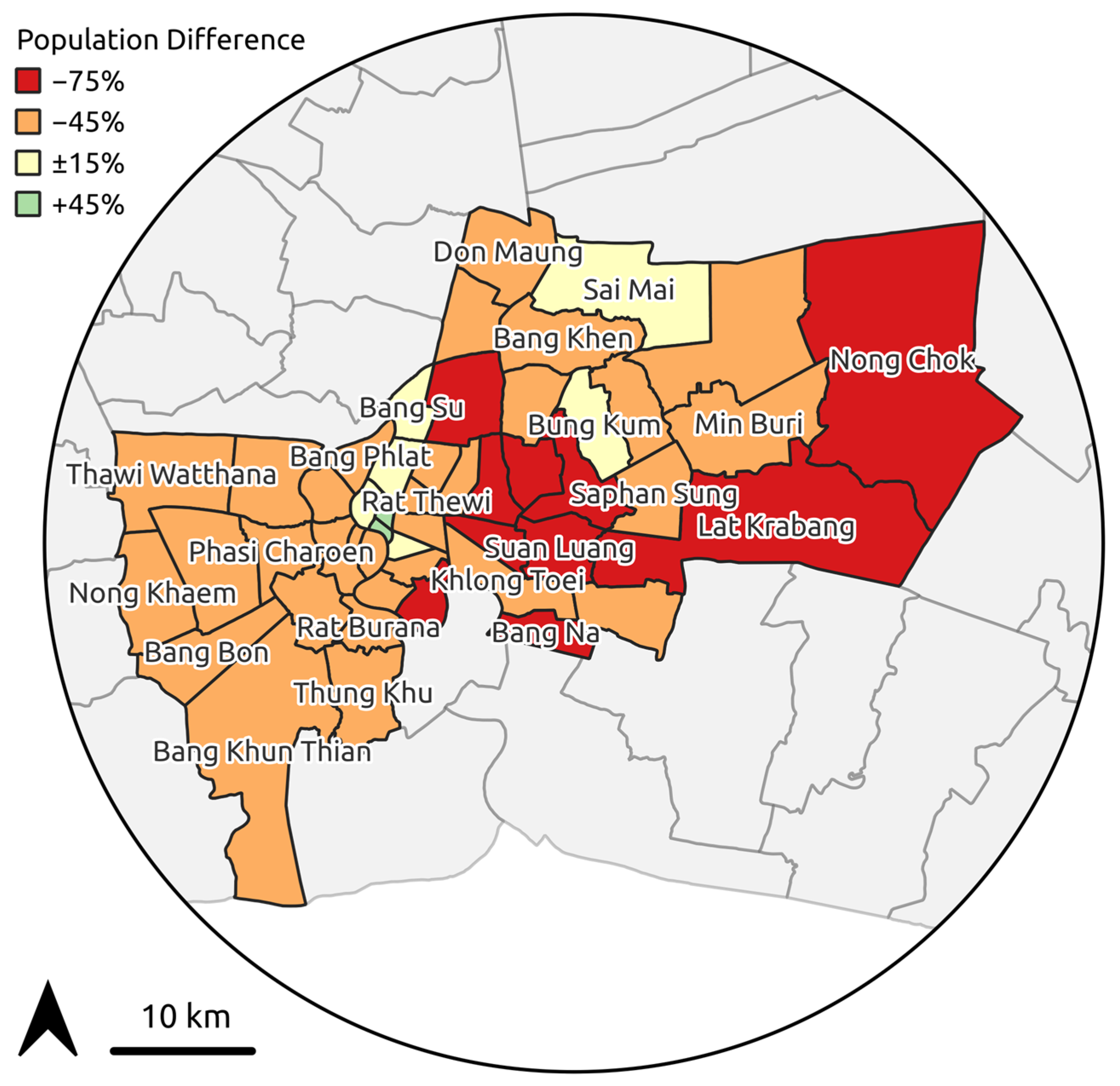
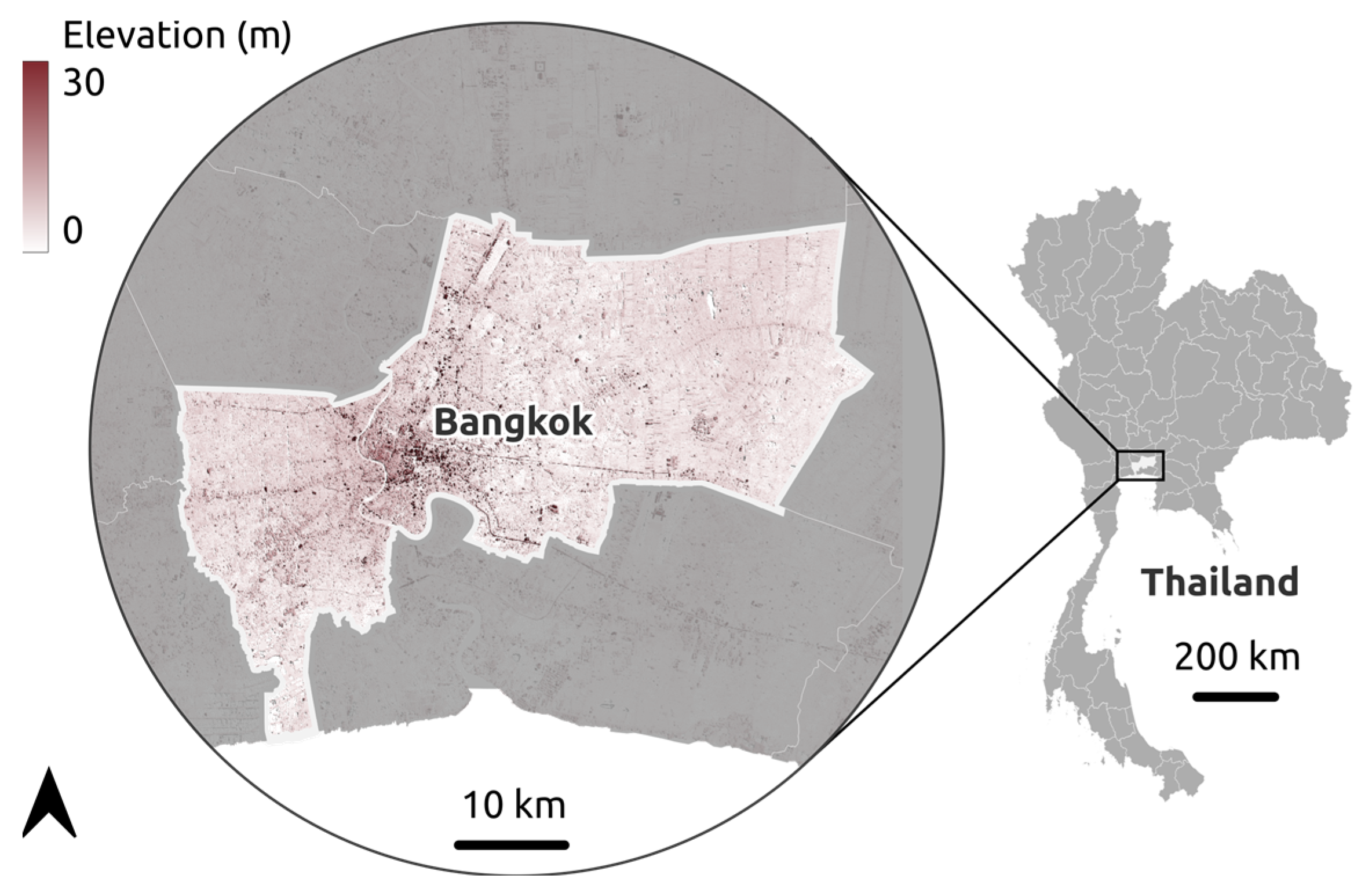
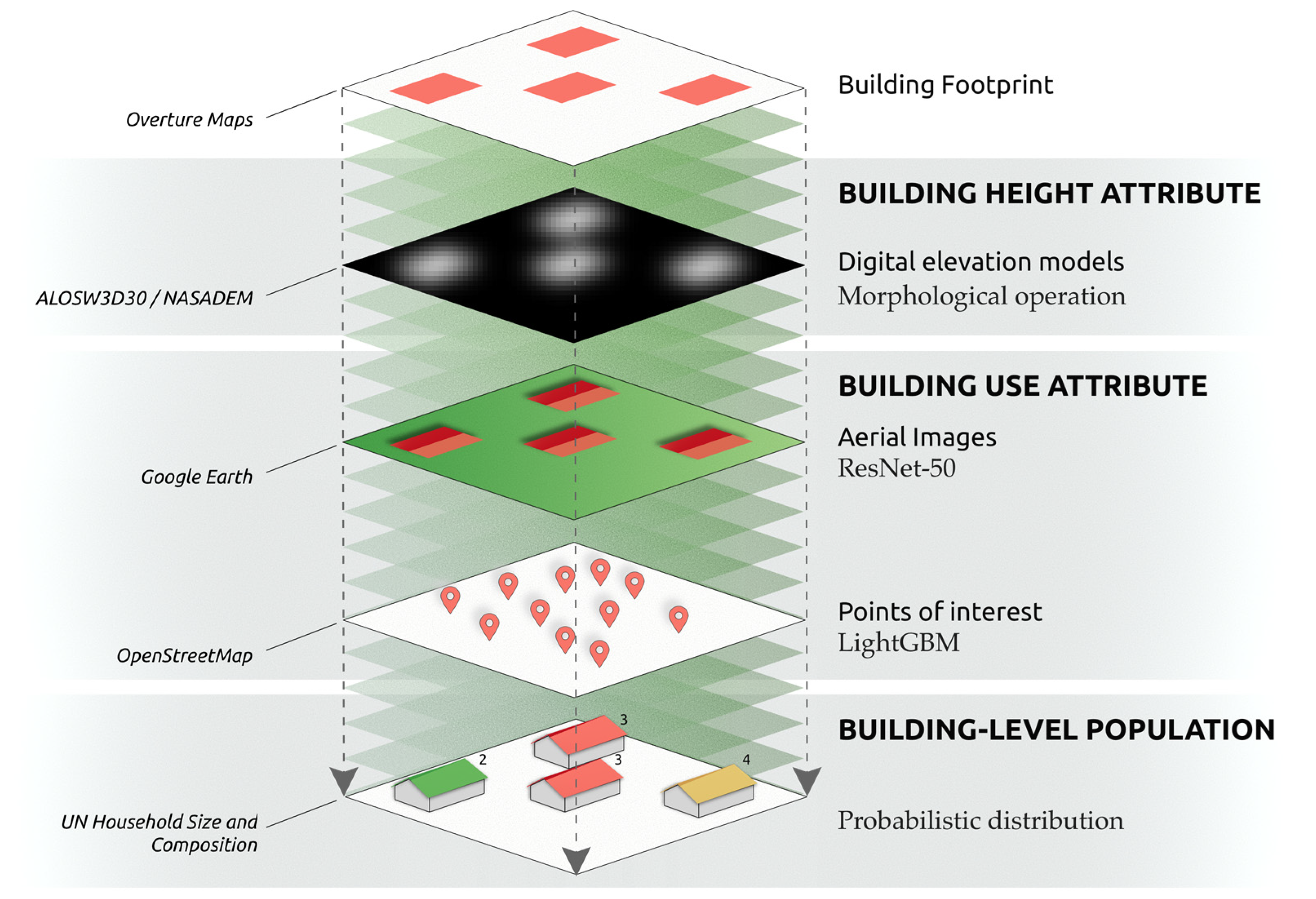
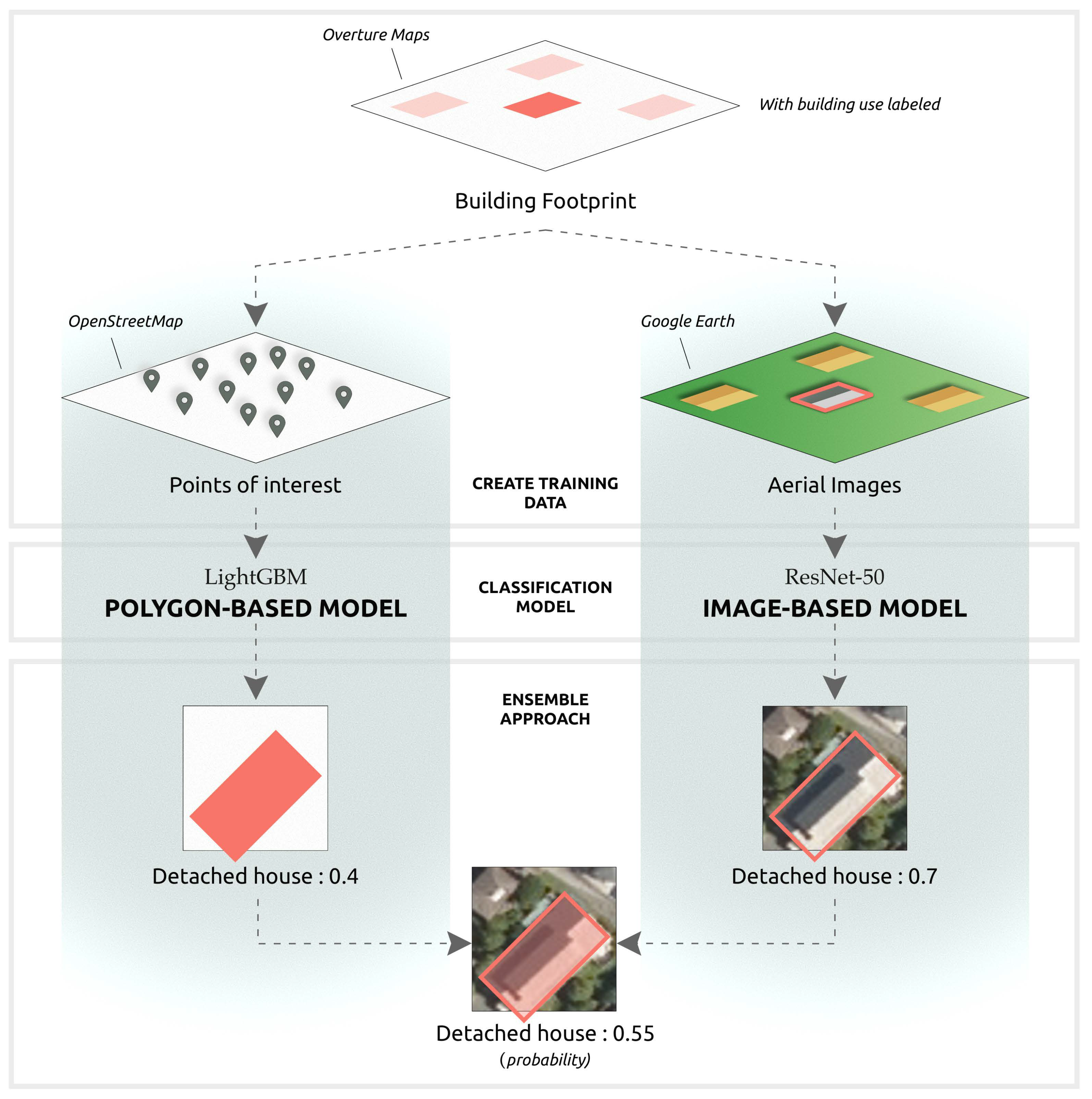


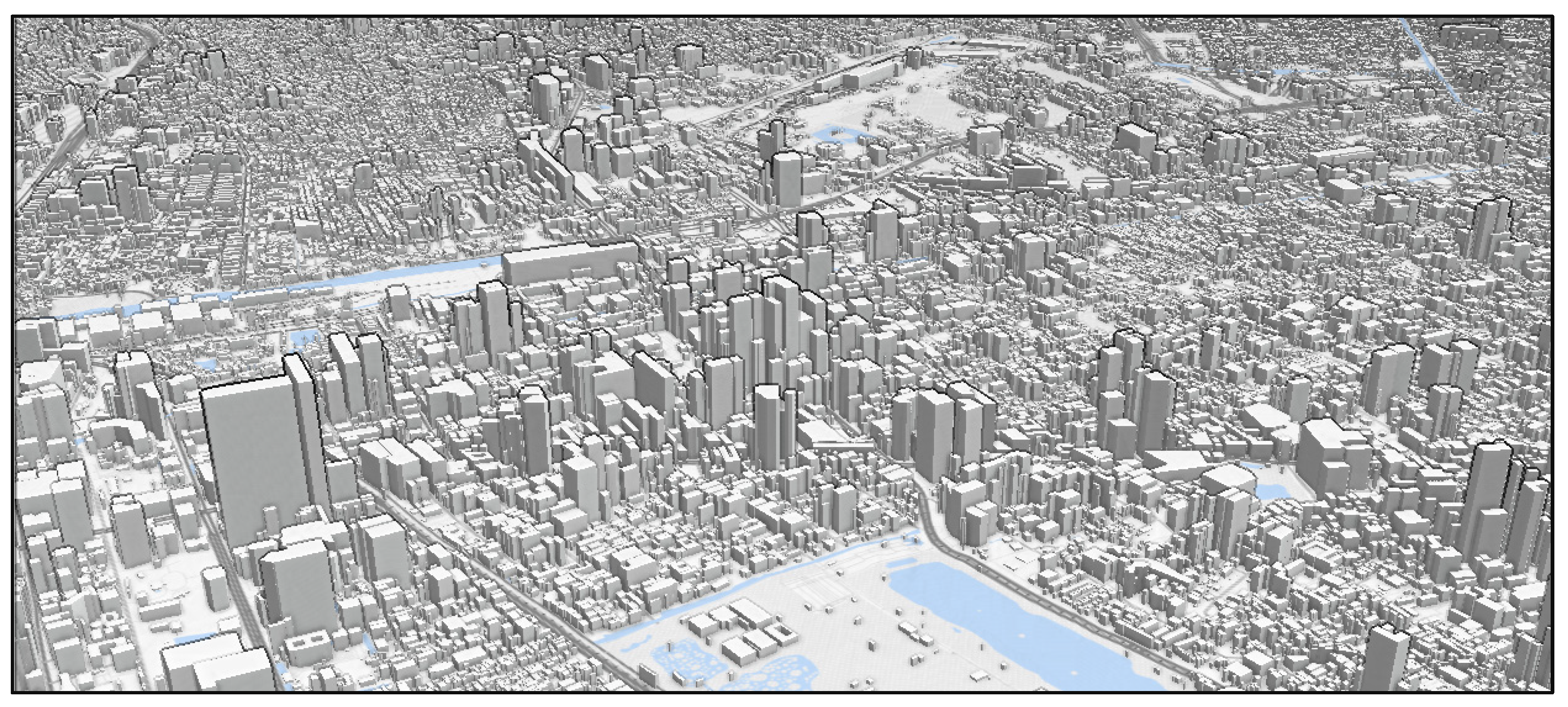

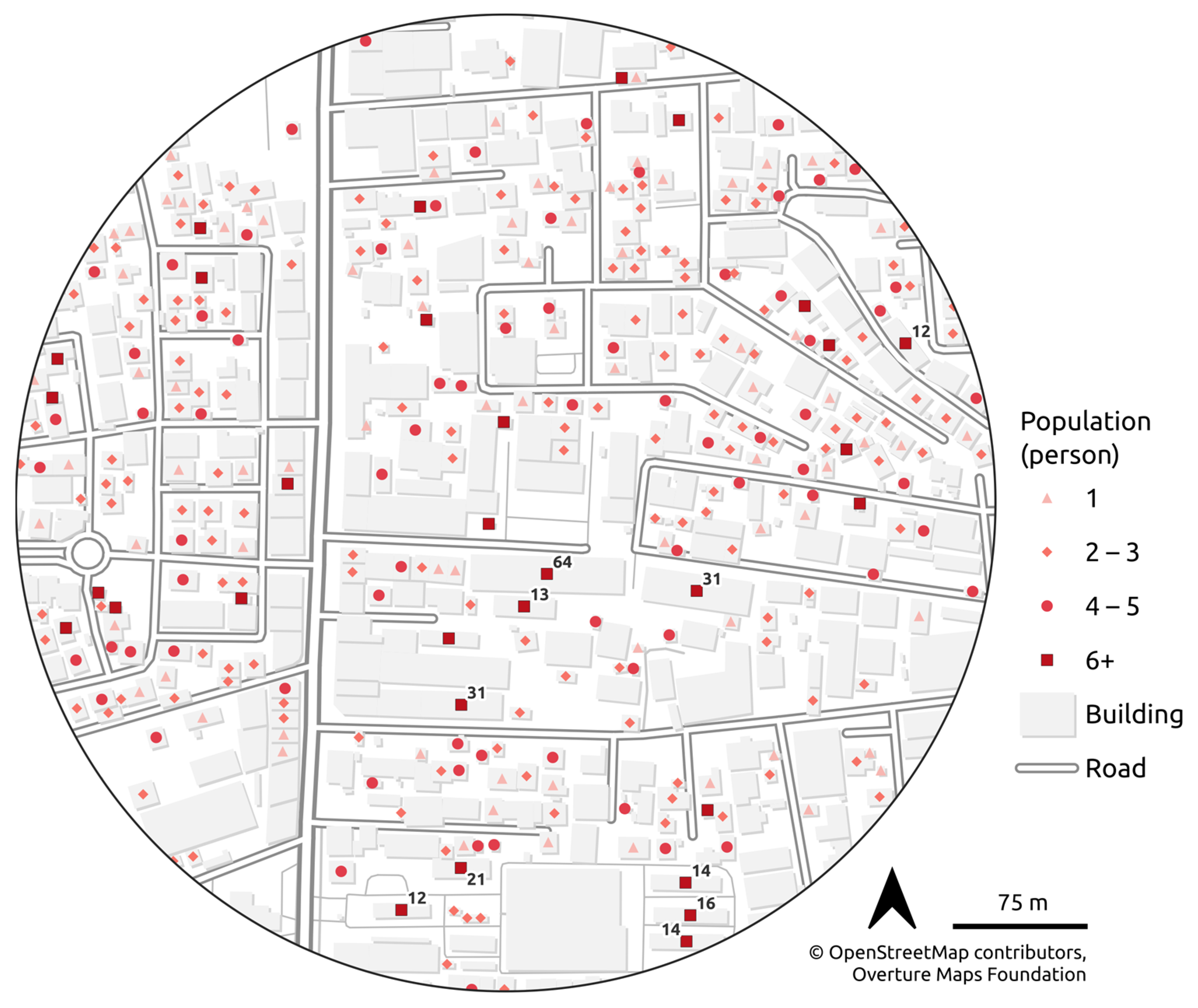
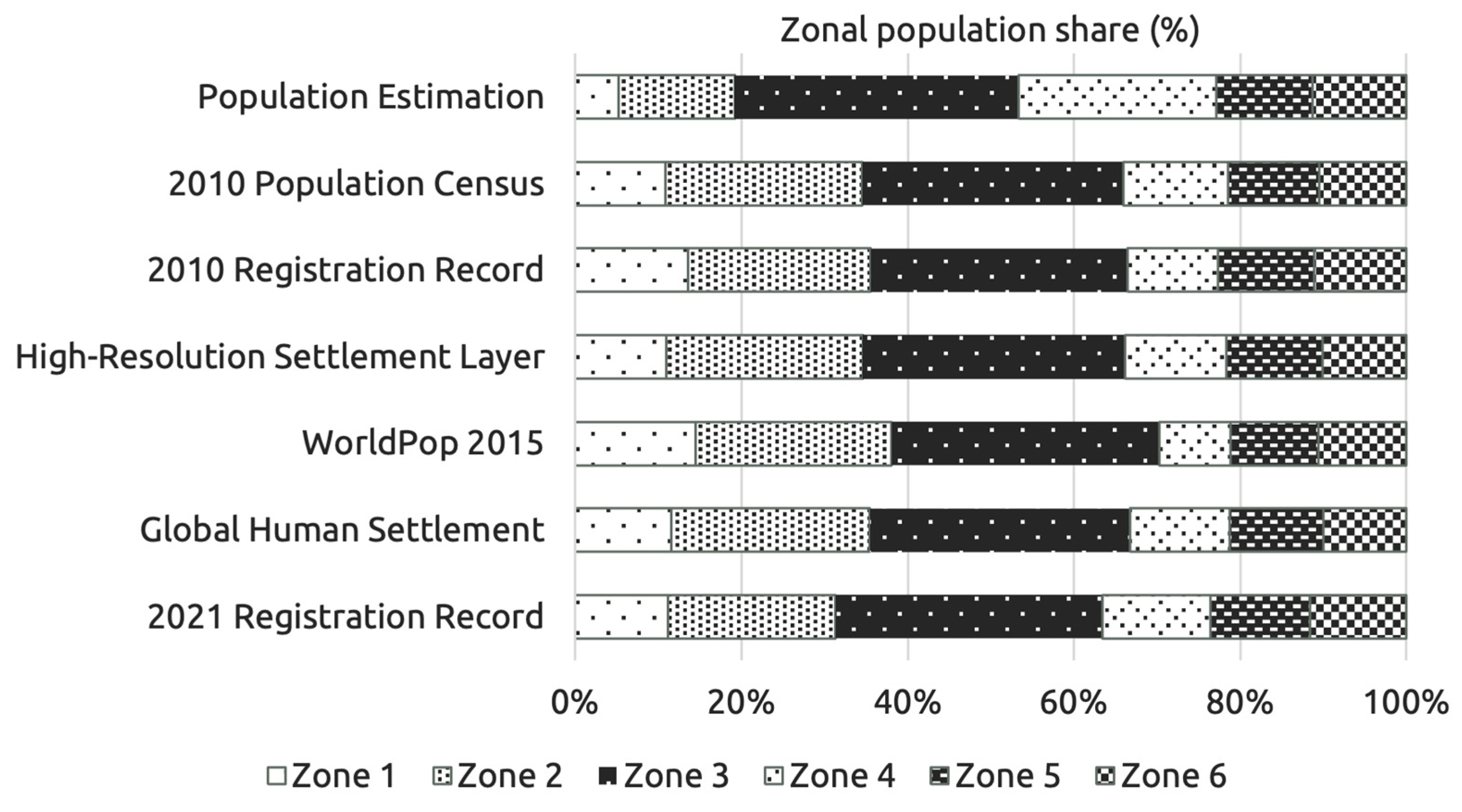

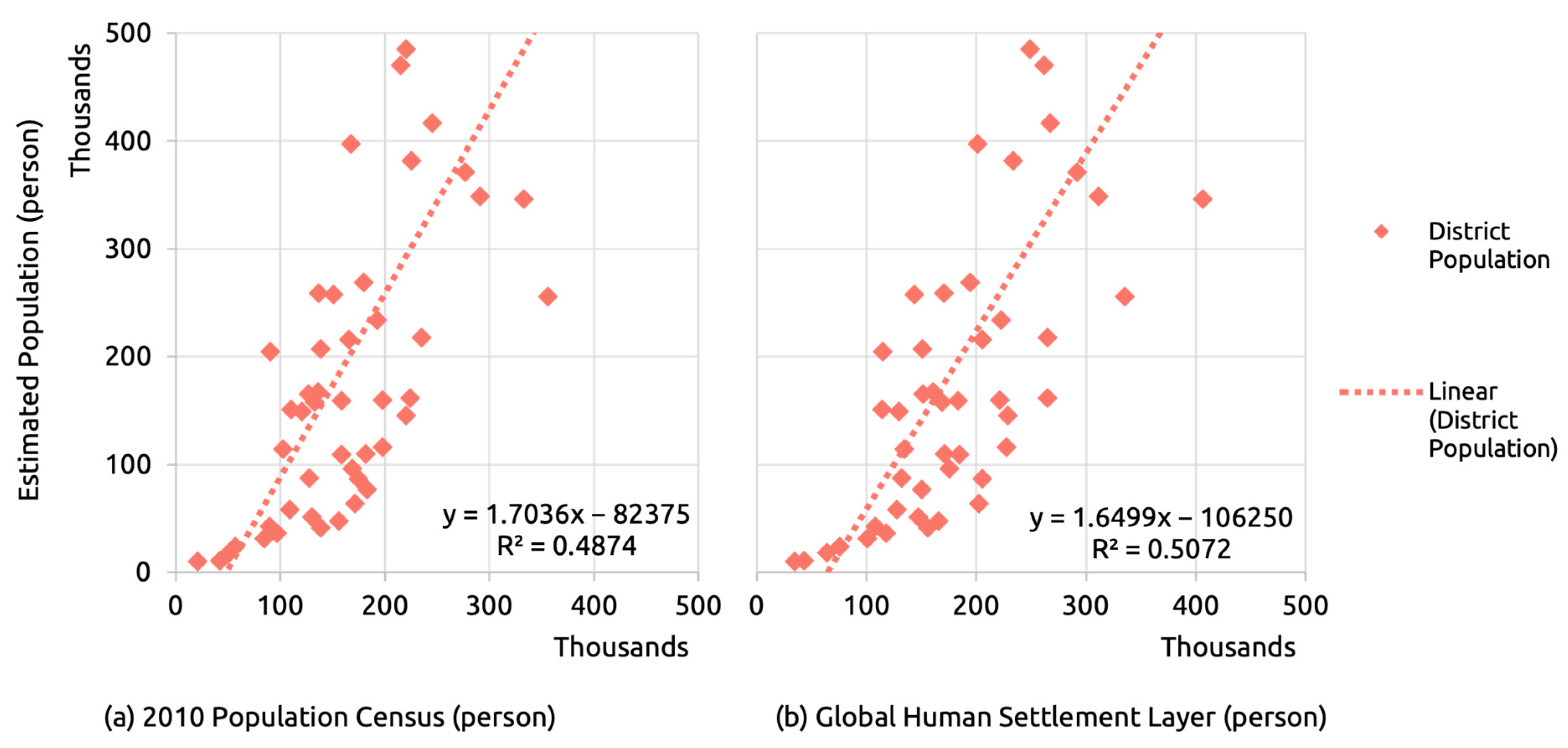
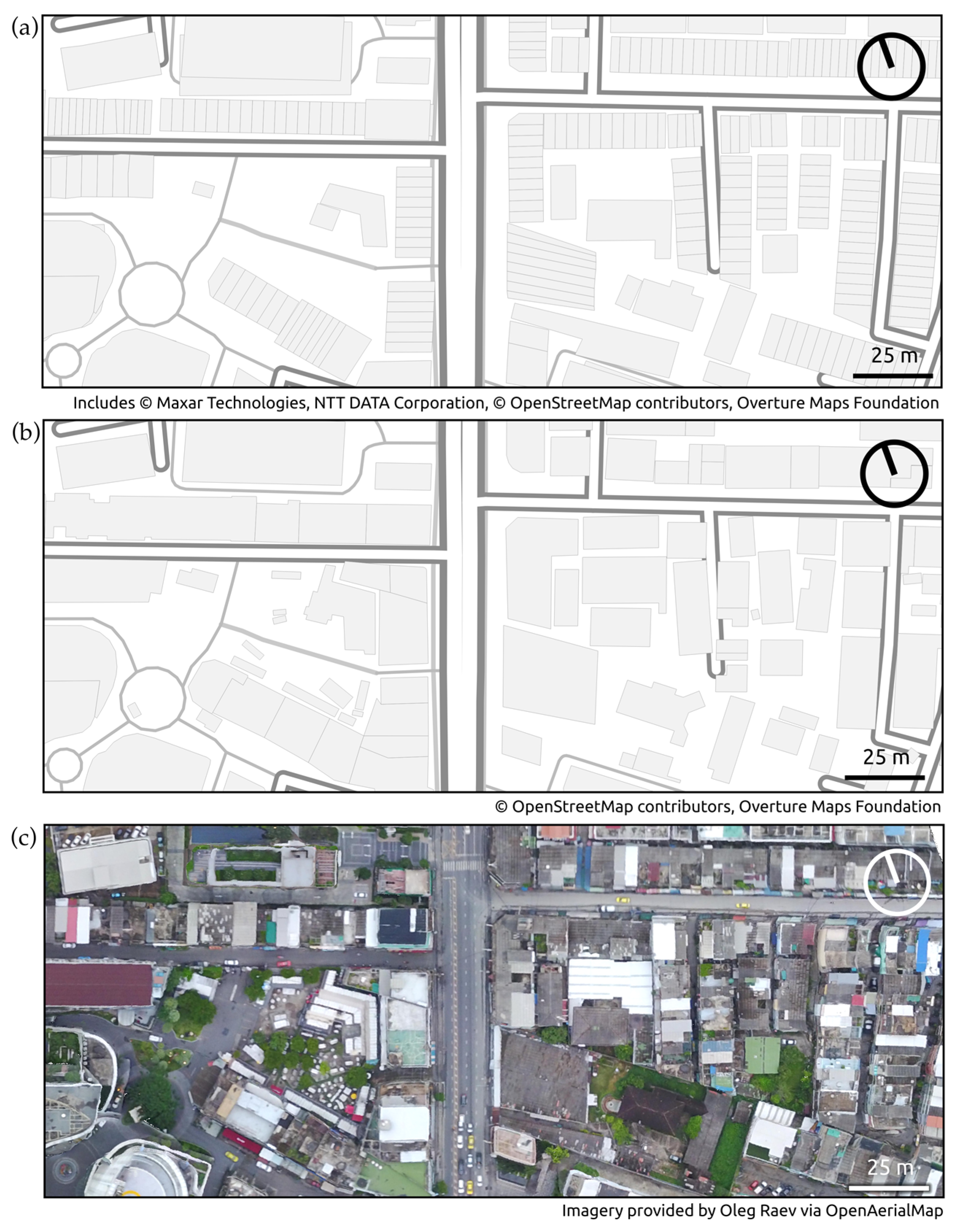
| Data Type | Provider | Temporal Coverage | Publication Date | Source |
|---|---|---|---|---|
| Building footprint | Overture Maps | 2024 * | 18 December 2024 | [48] |
| POI | OSM | 2024 * | N/A | [49] |
| Aerial images | Google Earth | 2024 * | N/A | |
| DSM | ALOS World 3D-30 m (ALOS AW3D30) | March 2016 | 7 December 2016 | [50] |
| DEM | NASADEM Global Digital Elevation Model | 21 February 2000 | 4 April 2021 | [51] |
| Household size and composition | United Nations | January 2019 | 2021 | [52] |
| Case | Data Availability | Allocation Method |
|---|---|---|
| 1 | Building location only | Population/households are distributed evenly across all buildings in the area, assuming equal importance. |
| 2 | Building location and footprint | Allocation is adjusted based on building size, with larger buildings receiving a proportionally higher share of population/households. |
| 3 | Building location, footprint, and height/number of floors | Allocation is proportional to building volume (calculated as footprint × height/number of floors). |
| 4 | Building location, footprint, and height/number of floors and usage data | Allocation is narrowed to residential buildings only (e.g., detached houses, condominiums), excluding non-residential buildings unless required. |
| 5 | Building location, footprint, and height/number of floors; usage data; and realistic fluctuations | Allocation incorporates variability, ensuring that residential units have differing household/resident numbers rather than uniform distribution. |
| Structuring Element Dimension (B) | R2 | MAE (m) | RMSE (m) | Accuracy of 5 m Confidence (%) |
|---|---|---|---|---|
| 3 × 3 | −0.122 | 6.26 | 10.79 | 58.12 |
| 5 × 5 | 0.002 | 5.18 | 9.99 | 71.90 |
| 7 × 7 | 0.035 | 4.68 | 9.71 | 77.44 |
| 9 × 9 | 0.052 | 4.39 | 9.55 | 80.18 |
| 11 × 11 | 0.060 | 4.20 | 9.46 | 81.79 |
| 13 × 13 | 0.062 | 4.09 | 9.40 | 82.54 |
| 15 × 15 | 0.061 | 4.01 | 9.37 | 82.94 |
| 17 × 17 | 0.058 | 3.96 | 9.35 | 83.13 |
| 19 × 19 | 0.053 | 3.93 | 9.34 | 83.21 |
| 21 × 21 | 0.045 | 3.91 | 9.34 | 83.07 |
| 23 × 23 | 0.036 | 3.92 | 9.36 | 82.81 |
| 25 × 25 | 0.022 | 3.95 | 9.40 | 82.31 |
| 27 × 27 | 0.006 | 4.00 | 9.44 | 81.73 |
| 29 × 29 | −0.015 | 4.07 | 9.51 | 81.06 |
| 31 × 31 | −0.035 | 4.15 | 9.58 | 80.46 |
| 33 × 33 | −0.051 | 4.22 | 9.63 | 79.75 |
| Best | 3.91 | 9.34 | 83.21 |
| Building Use | Precision | Recall | F1-Score |
|---|---|---|---|
| Townhouse | 0.646 | 0.316 | 0.424 |
| Detached house | 0.777 | 0.905 | 0.836 |
| Mixed-use building | 0.716 | 0.653 | 0.683 |
| Others | 0.791 | 0.447 | 0.571 |
| Overall Accuracy | 0.755 |
| Ground Truth | Classified Number of Structures | ||||
|---|---|---|---|---|---|
| Townhouse | Detached House | Mixed-Use Buildings | Others | Total Count | |
| Townhouse | 0.3156 | 0.4889 | 0.1867 | 0.0089 | 225 |
| Detached house | 0.0218 | 0.9054 | 0.0704 | 0.0025 | 1194 |
| Mixed-use building | 0.0180 | 0.3219 | 0.6529 | 0.0072 | 556 |
| Others | 0.0395 | 0.2763 | 0.2368 | 0.4474 | 76 |
| Total count | 110 | 1391 | 507 | 43 | 2051 |
| Country (Year of Aggregation) | Number of People in the Household (%) | |||
|---|---|---|---|---|
| 1 | 2–3 | 4–5 | 6+ | |
| Thailand (2019) | 21.50 | 48.62 | 23.39 | 6.41 |
| Dataset Name | Year | Total Population | Difference (%) | Source |
|---|---|---|---|---|
| Population estimation | 2024 * | 10,093,488 | - | This study |
| 2010 Population Census | 2010 | 8,294,235 | 21.69% | [24] |
| 2010 Registration Record | 2010 | 5,611,918 | 79.86% | [79] |
| High-Resolution Settlement Layer | 2015 | 9,210,179 | 9.59% | [80] |
| WorldPop 2015 | 2015 | 6,963,596 | 44.95% | [81] |
| Global Human Settlement | 2019 | 9,273,267 | 8.85% | [30] |
| 2021 Registration Record | 2021 | 5,440,544 | 85.52% | [79] |
| Dataset Name | Year | Total Household | Difference (%) | Source |
|---|---|---|---|---|
| Household estimation | 2024 * | 3,515,175 | - | This study |
| 2010 Population Census | 2010 | 2,881,752 | 21.98% | [24] |
| Zone Number | Zone Name in English |
|---|---|
| 1 | Cultural Conservation and Tourism Promotion Area |
| 2 | Central Business and Commercial District |
| 3 | Residential Area |
| 4 | Suburban Residential and Agricultural Area (Eastern) |
| 5 | Suburban Residential and Agricultural Area (Northwestern) |
| 6 | Suburban Residential and Agricultural Area (Southwestern) |
Disclaimer/Publisher’s Note: The statements, opinions and data contained in all publications are solely those of the individual author(s) and contributor(s) and not of MDPI and/or the editor(s). MDPI and/or the editor(s) disclaim responsibility for any injury to people or property resulting from any ideas, methods, instructions or products referred to in the content. |
© 2025 by the authors. Licensee MDPI, Basel, Switzerland. This article is an open access article distributed under the terms and conditions of the Creative Commons Attribution (CC BY) license (https://creativecommons.org/licenses/by/4.0/).
Share and Cite
Maneepong, K.; Yamanotera, R.; Akiyama, Y.; Miyazaki, H.; Miyazawa, S.; Akiyama, C.M. Towards High-Resolution Population Mapping: Leveraging Open Data, Remote Sensing, and AI for Geospatial Analysis in Developing Country Cities—A Case Study of Bangkok. Remote Sens. 2025, 17, 1204. https://doi.org/10.3390/rs17071204
Maneepong K, Yamanotera R, Akiyama Y, Miyazaki H, Miyazawa S, Akiyama CM. Towards High-Resolution Population Mapping: Leveraging Open Data, Remote Sensing, and AI for Geospatial Analysis in Developing Country Cities—A Case Study of Bangkok. Remote Sensing. 2025; 17(7):1204. https://doi.org/10.3390/rs17071204
Chicago/Turabian StyleManeepong, Kittisak, Ryota Yamanotera, Yuki Akiyama, Hiroyuki Miyazaki, Satoshi Miyazawa, and Chiaki Mizutani Akiyama. 2025. "Towards High-Resolution Population Mapping: Leveraging Open Data, Remote Sensing, and AI for Geospatial Analysis in Developing Country Cities—A Case Study of Bangkok" Remote Sensing 17, no. 7: 1204. https://doi.org/10.3390/rs17071204
APA StyleManeepong, K., Yamanotera, R., Akiyama, Y., Miyazaki, H., Miyazawa, S., & Akiyama, C. M. (2025). Towards High-Resolution Population Mapping: Leveraging Open Data, Remote Sensing, and AI for Geospatial Analysis in Developing Country Cities—A Case Study of Bangkok. Remote Sensing, 17(7), 1204. https://doi.org/10.3390/rs17071204










